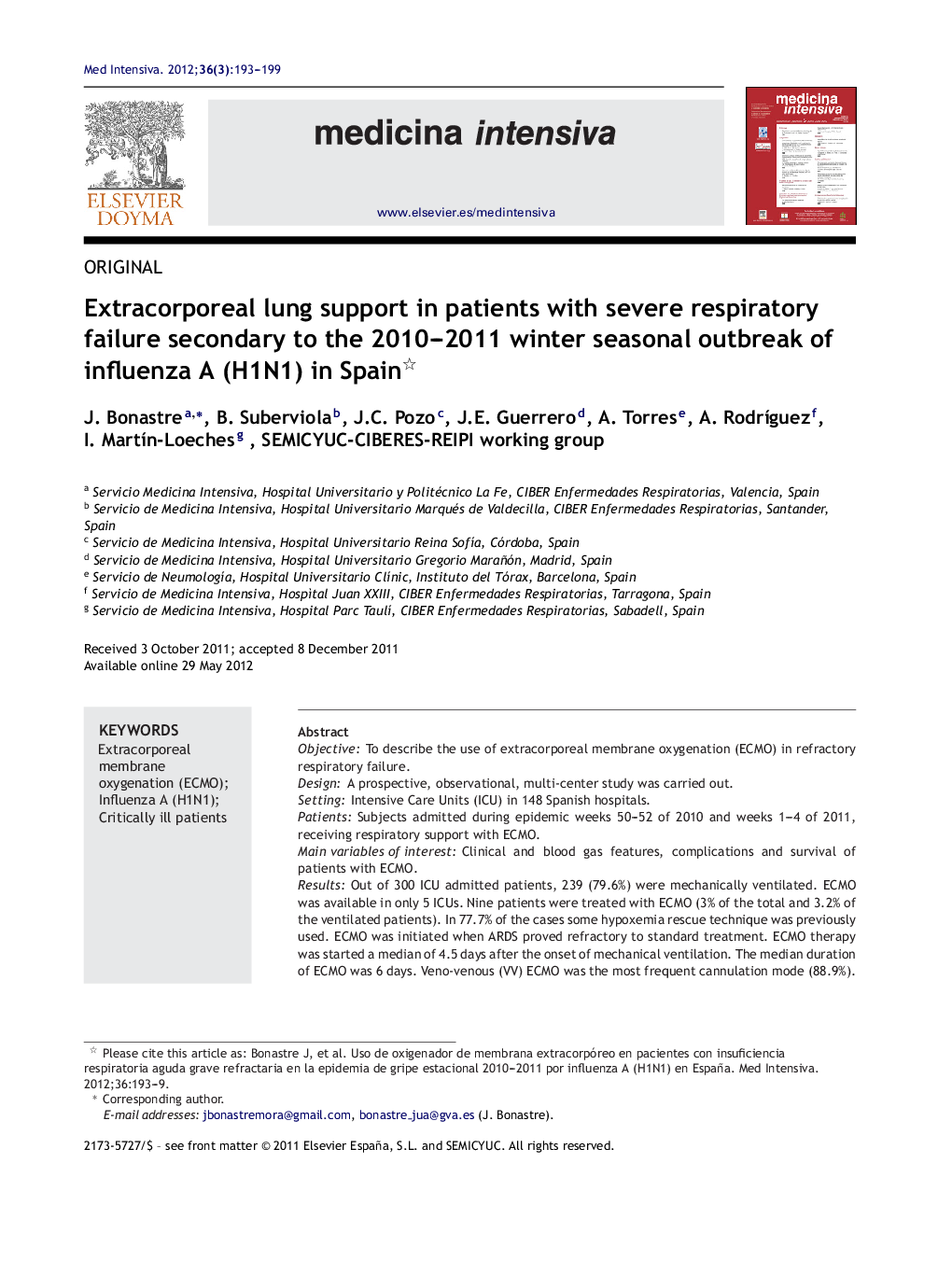| Article ID | Journal | Published Year | Pages | File Type |
|---|---|---|---|---|
| 3114334 | Medicina Intensiva (English Edition) | 2012 | 7 Pages |
ObjectiveTo describe the use of extracorporeal membrane oxygenation (ECMO) in refractory respiratory failure.DesignA prospective, observational, multi-center study was carried out.SettingIntensive Care Units (ICU) in 148 Spanish hospitals.PatientsSubjects admitted during epidemic weeks 50–52 of 2010 and weeks 1–4 of 2011, receiving respiratory support with ECMO.Main variables of interestClinical and blood gas features, complications and survival of patients with ECMO.ResultsOut of 300 ICU admitted patients, 239 (79.6%) were mechanically ventilated. ECMO was available in only 5 ICUs. Nine patients were treated with ECMO (3% of the total and 3.2% of the ventilated patients). In 77.7% of the cases some hypoxemia rescue technique was previously used. ECMO was initiated when ARDS proved refractory to standard treatment. ECMO therapy was started a median of 4.5 days after the onset of mechanical ventilation. The median duration of ECMO was 6 days. Veno-venous (VV) ECMO was the most frequent cannulation mode (88.9%). Four patients had complications associated with ECMO therapy. The median ICU and hospital stay was 17 and 29 days, respectively. In five patients (55.5%), ECMO assistance was satisfactory suspended. The ICU and hospital survival rate was 44.4%.ConclusionsThe use of ECMO in refractory respiratory failure in patients with influenza A (H1N1) is rare in Spain. The hospital survival achieved with its use allows it to be regarded as a possible rescue technique in these patients.
ResumenObjetivoDescribir la utilización de la oxigenación por membrana extracorpórea (ECMO) en la insuficiencia respiratoria refractaria.DiseñoEstudio prospectivo, observacional y multicéntrico.ÁmbitoServicios de Medicina Intensiva (SMI) de 148 hospitales españoles.PacientesEnfermos ingresados entre las semanas 50-52 del 2010 y la 1-4 del 2011 con el diagnóstico de gripe A (H1N1) que recibieron soporte respiratorio con ECMO.Principales variables de interéscaracterísticas clínicas, gasométricas, complicaciones y supervivencia de los pacientes con ECMO.ResultadosIngresaron 300 pacientes y se ventilaron 239 (79,6%). Sólo cinco SMI disponían de la técnica. Se indicó la ECMO en nueve (3% del total y 3,2% de los ventilados). En el 77,7% se empleó previamente alguna técnica de rescate frente a la hipoxemia. La canulación mayoritaria fue veno-venosa (88,9%). Su colocación fue precoz, tras una mediana de 4,5 días de ventilación mecánica. La duración mediana de la asistencia fue de seis días. Cuatro pacientes presentaron complicaciones asociadas a la ECMO. La mediana de estancia en el SMI y hospitalaria fue 17 y 29 días respectivamente. En cinco pacientes (55,5%) se pudo retirar la asistencia con la ECMO. La supervivencia tanto del SMI como hospitalaria fue del 44,4%.ConclusionesEl uso de la ECMO en la insuficiencia respiratoria refractaria en pacientes con gripe A (H1N1) es poco frecuente en nuestro país. La supervivencia hospitalaria lograda con su uso permite considerarla como una posible técnica de rescate en estos pacientes.
